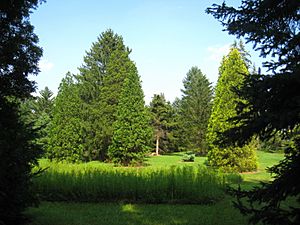Lee and Virginia Graver Arboretum facts for kids
The Lee and Virginia Graver Arboretum is a special outdoor place where many different trees and plants grow. It's about 63 acres big, which is like 48 football fields! Muhlenberg College owns this amazing spot. You can find it in Bath, Pennsylvania, and it's open every day for free.
Contents
A Special Place for Plants
This arboretum started over 40 years ago. It was created by Dr. Lee and Virginia Graver. They loved growing all sorts of plants. They carefully grew wildflowers, ferns, and beautiful rhododendrons. They also planted many native and rare trees. A big part of their collection was over 150 types of conifer trees. Conifers are trees that usually have needles and cones, like pines and spruces.
In 1994, the Gravers gave their property to Muhlenberg College. This made sure that everyone could continue to enjoy and learn from their amazing plant collection.
What You Can See at the Arboretum
The Graver Arboretum is home to many different kinds of plants. It's like a living museum where you can explore various plant groups.
Conifer Collection
One of the main collections at the arboretum is its conifers. These are evergreen trees that keep their needles all year round. You can see many different types, including:
- Firs (like Abies)
- Cedars (like Cedrus)
- Junipers (like Juniperus)
- Larches (like Larix)
- Spruces (like Picea)
- Pines (like Pinus)
- Redwoods (like Sequoiadendron)
- Cypress trees (like Taxodium)
- Hemlocks (like Tsuga)
It's a great place to learn how to tell these different cone-bearing trees apart!
Wetland Plants
The arboretum also has special areas dedicated to wetland plants. These are plants that love to grow in wet soil, near water, or even in water. They are very important for the environment.
Obligate Wetland Plants
Some plants are called "obligate wetland plants." This means they almost always grow in wet conditions. You might see plants like:
- American water plantain (Alisma subcordatum)
- Skunk cabbage (Symplocarpus foetidus)
- Cattails (Typha latifolia)
- Various types of water lilies and sedges.
Facultative Wetland Plants
Other plants are "facultative wetland plants." This means they can grow in wet areas, but they can also grow in drier spots. Some examples you might find are:
- Serviceberry trees (Amelanchier arborea)
- Jack-in-the-pulpit (Arisaema triphyllum)
- Yellow birch (Betula alleghaniensis)
- Witch hazel (Hamamelis virginiana)
- Sensitive fern (Onoclea sensibilis)
- Poison ivy (Toxicodendron radicans) – remember to look, but don't touch!
Exploring these different plant areas helps you understand how plants adapt to their environment.
See also
 In Spanish: Arboreto Graver para niños
In Spanish: Arboreto Graver para niños


